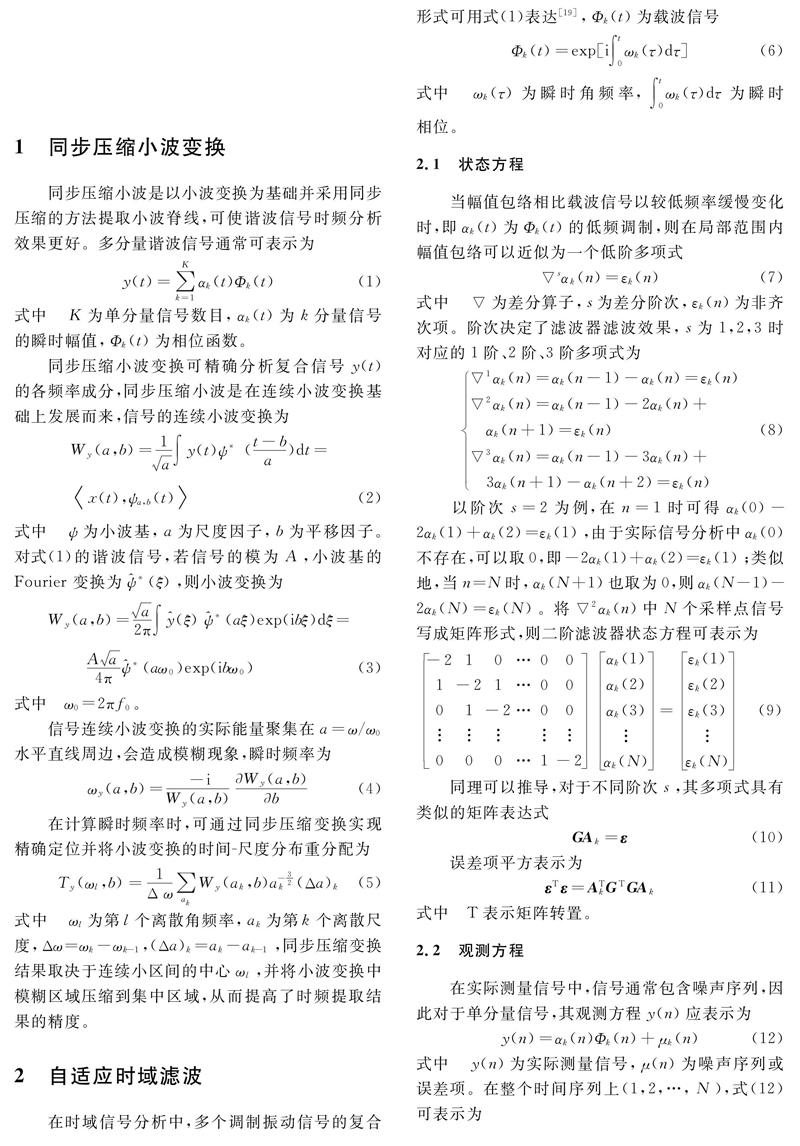应用小波时频脊提取和自适应滤波进行时变系统参数识别
张杰 史治宇



摘要: 提出了同步压缩小波时频脊提取结合自适应时域滤波的时变系统参数识别方法。同步压缩小波相比传统小波具有优异的时频分辨率,基于该小波时频脊提取可以获得时变结构的瞬时模态频率,在此基础上可构造各阶分量信号的载波矩阵,并应用自适应时域滤波求解分量信号的幅值包络,进而识别结构的阻尼比。该方法能对时变系统结构响应进行各阶分解,相比经验模态分解方法具有优异的时频提取能力、较强的抗噪性能和识别复杂时变问题的能力。在理论推导基础上,首先通过一个3自由度时变仿真算例验证了方法的正确性和抗噪性,再应用该算例构造了一个复杂时变算例(分量信号在频域重叠且突变),以此验证方法对各类复杂时变情况的适用性和准确性。
关键词: 参数识别; 同步压缩小波; 时频脊提取; 自适应滤波; 时变系统
中图分类号: TB123; O327 文献标志码: A 文章编号: 1004-4523(2019)03-0462-09
DOI:10.16385/j.cnki.issn.1004-4523.2019.03.011
引 言
现代工程结构逐渐迈向大型化、智能化、微型化的发展方向,结构时变问题随之凸显,例如:运载火箭发射时质量减小、高超声速飞行器气动加热引起结构刚度变化、空间太阳能板伸展引起结构时变等,因此结构时变问题研究无论在理论层面还是在实际应用上都有重大研究价值。
国内外现有线性时变系统参数识别的研究思路主要分两类[1]:第一类是基于短时时不变假设,对信号进行局部处理,应用信号处理方法(Gabor变换、Wigner-Ville分布[2]、小波變换[3-7])或子空间(Subspace)[8-10]进行参数识别;第二类是先将响应信号作为整体进行自适应分解,再对各阶响应信号进行参数识别[11-14]。第一类方法,短时时不变假设要求时域信号分析区间选取足够小但同时增加了计算量,因此算法都存在计算效率低、抗噪性能差、实用性不足的问题。第二类方法中较有代表性的是希尔伯特黄变换(HHT)[11],HHT方法通过经验模态分解可以自适应、高效地将信号分解为多个本征模态函数,进一步通过对每一个分量做希尔伯特变换,可在时频域得到良好的信号表示。然而,该方法难以处理多分量频率重叠或交叉信号,且存在模式混淆、“边界效应”等问题。
由于时变系统产生非平稳的振动响应,振动信号具有明显的时变调制特性,因此时频分析工具是一种较为理想的研究方法,常用时频分析工具都是由傅里叶变换发展而来,都存在上文所述的精度低、自适应不够、抗噪性能差等问题。
近年来,Daubechie等[15]提出了压缩小波变换(Synchrosqueezed Wavelet Transform, SWT)。该算法基于连续小波变换,通过对小波变换的复数谱沿频率轴方向压缩重排,具有较高的频率分辨率,能得到频率曲线更加集中的时频表达。同时自适应滤波在最小化结构和数据误差基础上,可有效分离在时频域内邻近甚至交叉的信号分量[16],自适应滤波在非平稳信号处理中尤其是故障诊断分析中具有广泛应用[17-18],然而时域滤波须获得待分离信号分量的瞬时频率载波矩阵。因此本文提出了将同步压缩小波时频脊提取引入到自适应滤波中,得到改进的自适应时频分解方法,并将其应用到时变系统参数识别中。该方法首先应用同步压缩小波时频脊提取脉冲响应信号的时频分布,根据其时频结果构造载波矩阵再应用时域滤波将响应信号自适应分解成多阶响应信号,最后再对各阶响应进行瞬时模态参数的识别。改进算法可有效提高识别的精度并增加其适用范围。
首先计算响应的压缩小波时频脊,结果如图7所示,可以看出结构的第2阶和第3阶分量在5-8 Hz存在重叠,且在20 s时频率发生突变。分别用本文方法和EMD方法对加速度响应进行分解,得到各个分量的时域信号,再对分量信号作短时傅里叶分析(STFT)来验证分解信号的频域成分。本文方法分解结果如图8所示,将结果和图7比较,可以看出3个分量的STFT结果和理论值是吻合的。EMD分解结果如图9所示,由于EMD存在较多虚假成分,因此按频率由低到高取能量较大的前4阶成分。将分解结果和图7比较,可以发现EMD分解在无改进情况下较难处理此种时变问题,第1分量和第4分量频率成分较混乱,第2分量含较多突变前频率成分,第3分量则含较多突变后频率成分,因此传统的EMD方法较难处理多分量信号重频或交叉的情况。
然后根据本文方法分解结果进行瞬时频率的识别,识别结果如图10所示。3阶频率识别结果都能较好地贴近理论值,仅在数据两端局部会误差稍大,并且方法对突变点也能较好追踪,总体来看本文方法相比EMD方法更适用在复杂时变情况的参数识别。同样地对信号添加不同信噪比的噪声考察方法的抗噪性,频率识别误差如表3所示,可以看出复杂时变情况下参数识别也几乎不受噪声影响。
5 结 论
(1) 本文提出了同步压缩小波时频脊提取结合自适应时域滤波的时变系统参数识别方法,该方法基于加速度响应信号进行数据的整体分解,具有较高的自适应性和实用性。
(2) 该方法利用压缩小波较高的时频分辨率能精确提取响应信号的各阶瞬时频率。
(3) 由于自适应时域滤波适用于非平稳信号处理,因此改进时频分解方法能得到精确的时变响应幅值包络,基于包络结果进行的阻尼识别也更准确,同时算法具有很好的抗噪性能,识别结果几乎不受噪声影响,抗噪性能优异。
(4) 相比EMD方法,本文方法适用范围更广,能应用在各类复杂时变结构中,并且可以追踪瞬时频率的各类变化(线性、周期和突变等)。
参考文献:
[1] 于开平, 庞世伟, 赵 婕. 时变线性/非线性结构参数识别及系统辨识方法研究进展[J]. 科学通报, 2009, 54(20): 3147-3156.
Yu Kaiping, Pang Shiwei, Zhao Jie. Advances in method of time-varying linear/nonlinear structural system identification and parameter estimate[J]. Chinese Science Bulletion (Chinese Version), 2009, 54(20): 3147-3156.
[2] 续秀忠, 华宏星, 张志谊, 等. 应用时频表示进行结构时变模态参数辨识[J]. 振动与冲击, 2002, 21(2): 36-40.
Xu Xiuzhong, Hua Hongxing, Zhang Zhiyi,et al. Time-varying modal frequency identification by using time-frequency representation[J]. Journal of Vibration and Shock, 2002, 21(2): 36-40.
[3] Ghanem R, Romeo F. A wavelet-based approach for the identification of linear time-varying dynamic systems[J]. Journal of Sound and Vibration, 2000, 234(4): 555-576.
[4] 邹甲军, 冯志化, 陆维生. 基于小波的LTV系统的参数识别[J]. 苏州大学学报(工科版), 2005, 25: 41-46.
Zou Jiajun, Feng Zhihua, Lu Weisheng. Model parameter identification of LTV systems based on Daubechies wavelet[J]. Journal of Soochow University (Engineering Science Edition), 2005, 25: 41-46.
[5] Xu X, Shi Z Y, You Q. Identification of linear time-varying systems using a wavelet-based state-space method[J]. Mechanical Systems and Signal Processing, 2012, 26: 91-103.
[6] Hera A, Shinde A, Hou Z K. Issues in tracking instantaneous modal parameters for structural health monitoring using wavelet approach[C]. Proceedings of 23rd International Modal Analysis Conference (IMAC XXIII), Orlando, Florida, USA, 2005: 338-347.
[7] Dziedziech K, Staszewski W J, Basu B, et al. Wavelet-based detection of abrupt changes in natural frequencies of time-variant systems[J]. Mechanical Systems and Signal Processing, 2015, 64-65:347-359.
[8] Liu K. Identification of linear time-varying systems[J]. Journal of Sound and Vibration, 1997, 204: 487-500.
[9] 龐世伟, 于开平, 邹经湘. 识别时变结构模态参数的改进子空间方法[J]. 应用力学学报, 2005, 22: 184-188.
Pang Shiwei, Yu Kaiping, Zou Jingxiang. Improved subspace method with application in linear time-varying structural modal parameter identification[J]. Chinese Journal of Applied Mechanics, 2005, 22: 184-188.
[10] Tasker F, Bosse A, Fisher S. Real-time modal parameter estimation using subspace methods: Theory[J]. Mechanical Systems and Signal Processing, 1998, 12: 797-808.
[11] Feldman M. Nonlinear system vibration analysis using Hilbert transform II: Forced vibration analysis method[J]. Mechanical Systems and Signal Processing, 1994, 8(3): 309-318.
[12] Shi Z Y, Law S S. Identification of linear time-varying dynamical systems using Hilbert transform and EMD[J]. Journal of Applied Mechanics, 2007, 74(2): 223-230.
[13] Bao C X, Hao H, Li Z X, et al. Time-varying system identification using a newly improved HHT algorithm[J]. Computers and Structures, 2009, 87:1611-1623.
[14] 程军圣, 张 亢, 杨 宇, 等. 局部均值分解与经验模式分解的对比研究[J]. 振动与冲击, 2009, 28(5):13-16.
Cheng Junsheng, Zhang Kang, Yang Yu, et al. Comparison between the methods of local mean decomposition and empirical mode decomposition[J]. Journal of Vibration and Shock, 2009, 28(5):13-16.
[15] Daubechies I, Lu F J, Wu H T. Synchrosqueezed wavelet transforms: An empirical mode decomposition like tool[J]. Applied and Computational Harmonic Analysis, 2011, 30:243-261.
[16] Vold H,Herlufsen H,Mains M.Multi axle order tracking with the Vold-Kalman tracking filter[J].Journal of Sound and Vibration, 1997, 13(5):30-34.
[17] 秦嗣峰,冯志鹏,Liang Ming. Vold-Kalman滤波和高阶能量分离在时变工况行星齿轮箱故障诊断中的应用研究[J]. 振动工程学报,2015,28(5):839-845.
Qin Sifeng, Feng Zhipeng, Liang Ming. Application of Vold-Kalman filter and higher order energy separation to fault diagnosis of planetary gearbox under time-varying conditions[J]. Journal of Vibration Engineering, 2015, 28(5):839-845.
[18] 冯 珂,王科盛,宋理伟,等. 基于阶次谱的Vold-Kalman滤波带宽优选方法[J]. 振动工程学报,2017,30(02):319-324.
Feng Ke, Wang Kesheng, Song Liwei, et al. An order spectrum based selection method to Vold-Kalman filter bandwidth[J]. Journal of Vibration Engineering, 2017, 30(02):319-324.
[19] Vold H, Mains M, Blough J. Theoretical foundations for high performance order tracking with the Vold-Kalman tracking filter[C]. SAE Noise and Vibration Conference and Exposition, 1997:1083-1088.
[20] Feldauer Ch, Hldrich R. Realisation of a Vold-Kalman tracking filter——A least square problem[C]. Proceedings of the COST G-6 Conference on Digital Audio Effects (DAFX-410800), Verona, Italy, 2000: 7-9.
[21] Tuma J. Setting the pass bandwidth in the Vold-Kalman order tracking filter[C]. Twelfth International Congress on Sound and Vibration, Lisbon, 2005, Paper 719.
Abstract: In this paper, an instantaneous modal parameter identification method for time-varying structures based on synchrosqueezed wavelet transform (SWT) and adaptive filtering is proposed. The time-frequency ridges of SWT are applied to the instantaneous frequency extraction of time-varying structures for their excellent time-frequency resolution. Then the carrier matrix of each order component signal can be constructed and the component signal amplitude envelope is calculated based on the adaptive filter. On this basis, the structural damping ratio is identified. Compared with the empirical mode decomposition, this method has excellent time-frequency extraction capability, strong noise immunity and strong applicability for various time-varying conditions. Based on the theory, the results of a three-degree-of-freedom time-varying simulation verify the correctness and anti-noise ability of the method. The example is also used to construct a complex time-varying situation in order to verify the applicability of the method, and the results show that this method can be applied to time-varying situations that component signals overlap or even intersect in frequency domain.
Key words: parameter identification; synchrosqueezed wavelet transform; time-frequency ridges extraction; adaptive filtering; time-varying system
作者簡介: 张 杰(1988-),男,博士研究生。电话:18551670428;E-mail:jzhang1988@nuaa.edu.cn
通讯作者: 史治宇(1967-),男,博士,教授,博士生导师。电话:18914704215;E-mail:zyshi@nuaa.edu.cnZ ··y^

